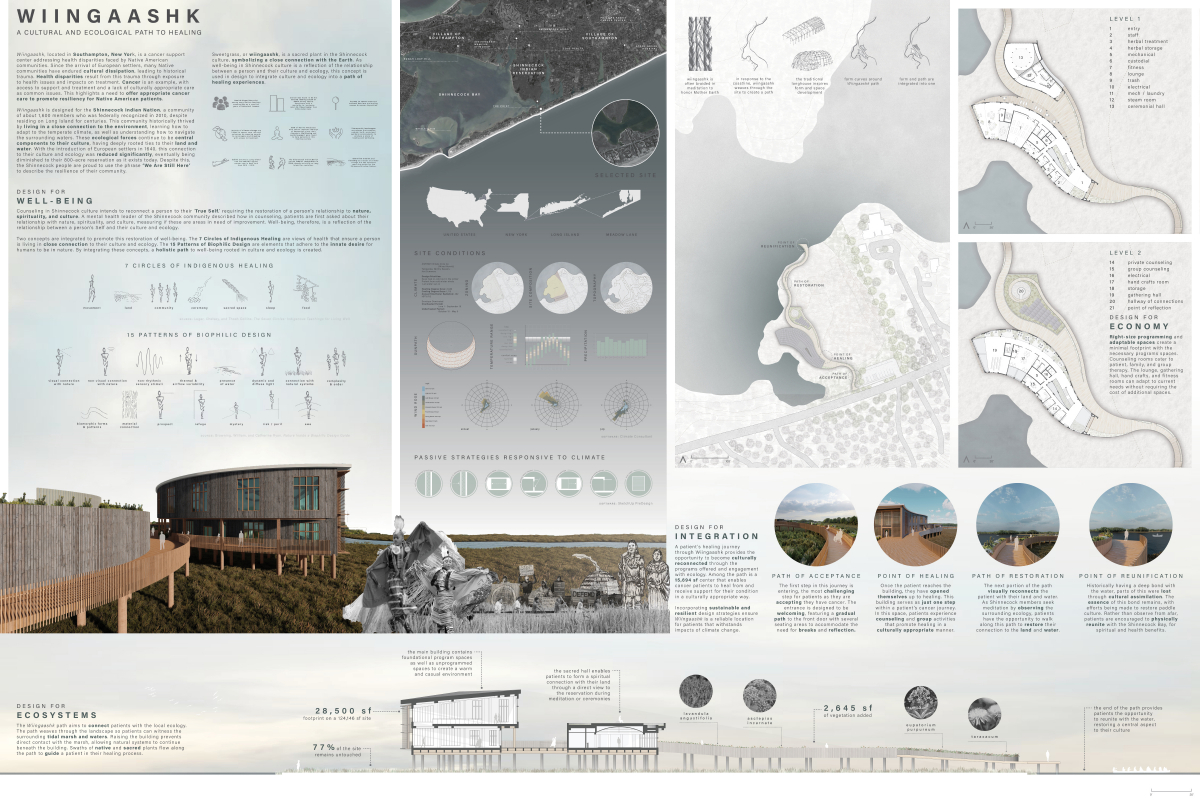
We are proud to share that the American Institute of Architects Committee on the Environment (AIA COTE), in partnership with the Association of Collegiate Schools of Architecture (ACSA), has chosen Catholic University of America student Isabelle Cassidy as the winner of the 2023 AIA COTE Top Ten for Students Competition:
"The competition recognizes 10 exceptional studio projects that integrate creative and innovative design strategies. These projects work toward achieving carbon-neutral operations through daylighting, passive heating and cooling systems, sustainable materials, water conservation, energy generation, and other sustainable systems."
WIINGAASHK: A CULTURAL AND ECOLOGICAL PATH TO HEALING

Student: Isabelle Cassidy
Faculty: Patricia Andrasik
Collaborator: Jim Lutz
Juror Comments:
Wiingaashk: A Cultural and Ecological Path to Healing is an impressive design by the technical skills and expertise that the project employs. The diagrams are laid out in a way to show a broader context of the whole site. Using the experimentation of Hydrothermal analysis and limited embodied carbon modeling executes the solution elegantly.
Project Description:
Wiingaashk, located in Southampton, New York, is a cancer support center aimed at addressing health disparities faced by Native American communities. Since the arrival of European settlers, many Native communities have endured cultural dissipation, leading to historical trauma that often cause health disparities. Cancer is an example, with a lack access to support and treatment and a lack of culturally appropriate care as common issues. This highlights a need to offer appropriate cancer care to promote resiliency for Native American patients. Wiingaashk is designed for the Shinnecock Indian Nation, a community of about 1,600 members who was federally recognized in 2010, despite residing on Long Island for centuries. This community historically thrived by living in a close connection to the environment, learning how to adapt to the temperate climate, ASHRAE Climate Zone 4a, as well as understanding how to navigate the surrounding waters. These ecological forces continue to be central components to their culture, having deeply rooted ties to their land and water. With the introduction of European settlers in 1640, this connection to culture and ecology was reduced significantly, eventually being diminished to their 800-acre reservation as it exists today. Despite this, the Shinnecock people are proud to use the phrase ‘We Are Still Here’ to describe the resilience of their community. A mental health leader of the Shinnecock community described how in counseling, patients are first asked about their relationship with nature, spirituality, and culture, measuring if these are areas in need of improvement. Well-being, therefore, is a reflection of the relationship between a person’s Self and their culture and ecology. Sweetgrass, or wiingaashk, is a sacred plant in the Shinnecock culture, symbolizing a close connection with the Earth. This concept is used in design to integrate culture and ecology into a path of healing experiences. As many people seek meditation by observing the surrounding ecology on the edge of the reservation, Wiingaashk provides patients the opportunity to view their land and water. The essence of wiingaashk becomes a tool to weave patients throughout the site, reconnecting them to their culture and restoring their relationship with ecology. Among the path is a 15,694 SF center, providing foundational spaces that promote healing and well-being. The program spaces are organized as a representation of a patient gradually accepting themselves to their cancer journey, beginning with private spaces, then open social spaces, and ending with a spiritual connection to their land. A patient’s healing journey through Wiingaashk provides the opportunity to become culturally reconnected through the programs offered and engagement with ecology. Wiingaashk becomes a reliable location for cancer patients to heal from and receive support for their condition. Using resilient strategies in design enables Wiingaashk to withstand the conditions of time, representative of a community that has remained on their land despite the continuous attempts to dissipate their culture. In this way, Wiingaashk is a direct reflection of the phrase that is deeply engrained in Shinnecock culture – we are still here.
Read more about the competition and winners here

